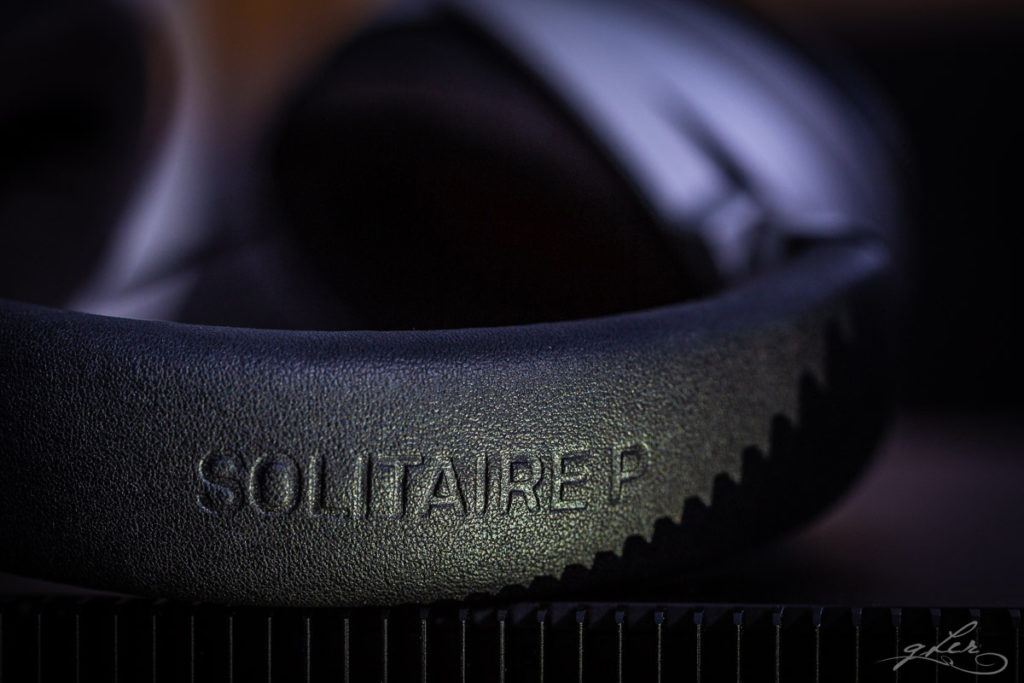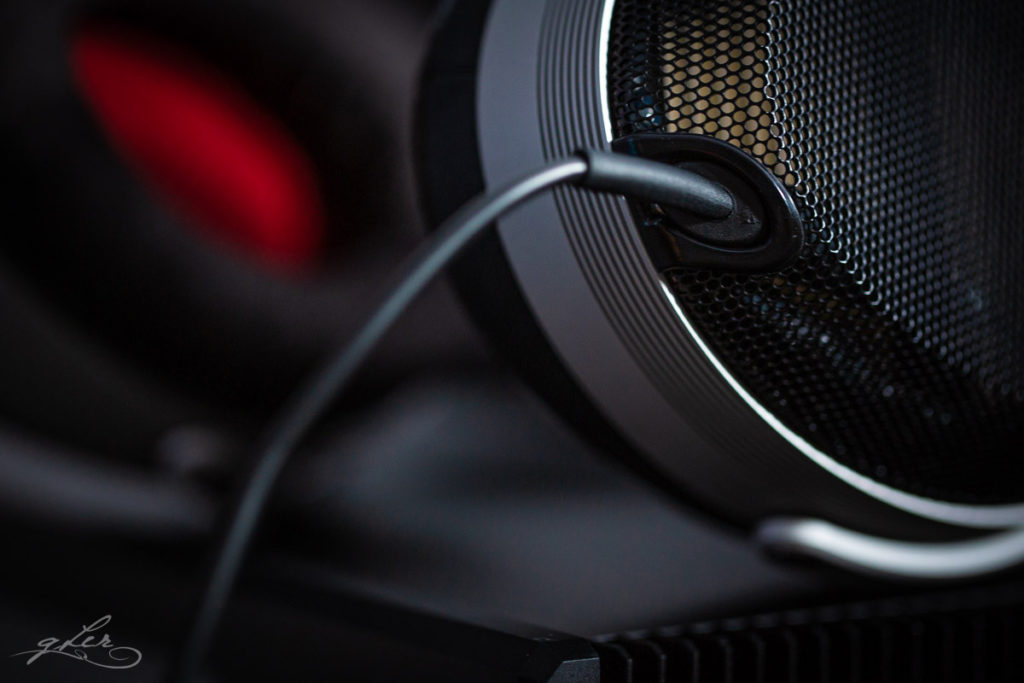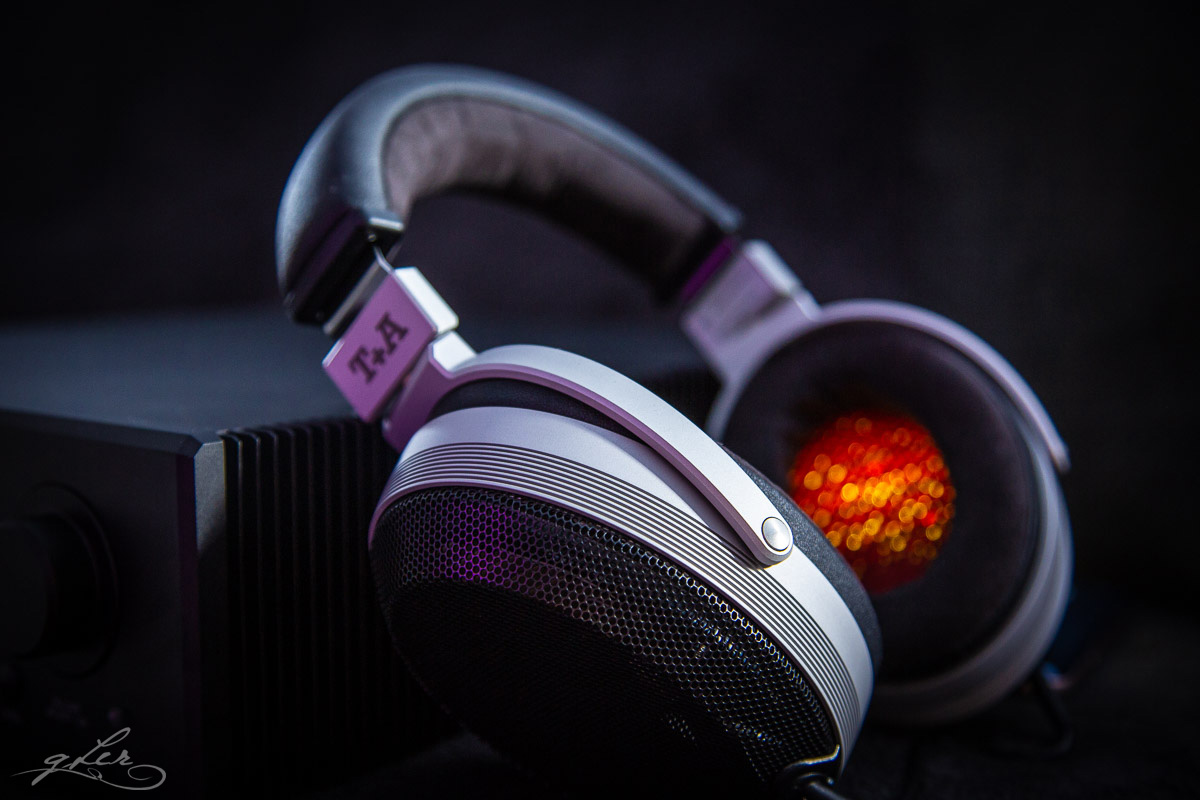Sound Impressions
Despite its eye-watering price, the Solitaire P is not a headphone that wows you on first listen. If you’re someone expecting to pick it up at a trade show or demo room and immediately be blown away by its power, dynamism, or extreme detail, you may walk away disappointed. But experience has taught me that headphones that don’t necessarily wow you at first are also the ones with the longest staying power, and this has proven to be true yet again with the Solitaire P.
Tonality
I’d describe the overall tonality of the Solitaire P as neutral musical, with a hint of warmth in the lower regions, a more relaxed upper-frequency tuning, and a perfectly balanced response throughout the spectrum. I’ve heard some describe the Solitaire P as dark, but that’s not a word I’d use myself. Side-by-side with brighter, airier headphones like Susvara and HD 800 it’s definitely darker, but then just about any headphone can be considered darker relative to those two.

Bass
It’s no secret that I’m a fan of dynamic drivers, specifically for their visceral bass response and physical air movement. I’ve often found planar magnetic headphones and electrostats fall short of my preferences in this area, not moving enough air for the physical vibrations I enjoy (Stax headphones, in particular, would be my last choice if you’re looking for a physical bass response or any sort of sub-bass extension for that matter).
That said, planars and stats generally compensate for their physical shortcomings with a tight, textured, ultra-fast bass that’s not necessarily natural, but instead is far more revealing. To my surprise, the Solitaire P combines the best of both worlds, with a fast and precise planar bass that somehow manages to evoke the weight and movement of dynamic drivers. It’s not entirely natural, the decay on some low rumbles and drum kicks trailing off faster than I’d like on some tracks, but it still gives me most of the dynamic tactility I enjoy.
The big drum hits in Dadawa’s epic Sister Drum, the title track of the album, reveals excellent texture as the stick hits the tanguu drum skin. It’s not quite as huge as I’ve heard it with more bass-tilted dynamic headphones, but absolutely on point in terms of realism.
Reb Fountain’s beautifully rendered bassline in Psyche is not bloated, nor does it veil her delicate vocals, suggesting sub-bass to midbass progression is tilted downward, just as I like it, but not really in favour of either. I hear as much thwack as I do rumble, with quality abundant across the bass range.
As you’d expect from a completely open-back headphone, SolP’s sub-bass weight does suffer slightly, but only when compared to closed headphones. Spinning some EDM with Armin van Buuren’s Intense, the SolP lacks the last mile of sub-bass weight I’d want from a subwoofer-like transducer, but that’s not what the SolP is about. The speed, rhythm, texture and detail of every instrument and effect is off the charts, as is the pacing. Because it doesn’t have the subterranean sub-bass weight, the overall presentation is skewed slightly brighter, but still full-bodied and rich. It’s more of a cerebral presentation of this track than the outright toe-tapping, fist-pumping experience it can be, but that’s ok. It’s a different way to listen to a very familiar track in a whole new way, and in that regard, it shines.
Overall, while its bass may not be as nuanced as Susvara or a high-end LCD, SolP has as much or more physicality as an LCD and certainly more presence than Susvara, and I daresay a more satisfying bass delivery than both.

Midrange
This is where, to me, the Solitaire P elevates itself above other planar and electrostatic front-runners, with a rich, textured, incredibly detailed, and – depending on the source – indelibly present vocal presentation. Paired with the HA-200, vocals appear right between my eyes, deep inside my head, as if I am the microphone to the performer’s voice. This makes every note, every inflection, so perfectly clear, that songs I’ve known for decades are a revelation all over again.
Iva Davies’ trademark vocals in Icehouse’s Crazy are as deep and chesty as you’d want them, but also nuanced and immediate despite the abundance of synths and drums on the track. The same goes for Neil Diamond’s raspy vocals on Hello Again, one of his most emotively powerful tracks from The Jazz Singer.
Female vocals are equally pristine. You know you’re listening to a true high-fidelity headphone when you stop dead and listen intently to a song you’ve heard dozens of times before because it’s like you’re hearing it for the first time. Brandi Carlile’s The Story is a case in point. Blessed with one of the most evocative voices of our generation, Brandi grips you from the very first note, and then, when the percussion and piano join the party, it’s like a fusion of the beautiful and ethereal. Every guitar strum, every snare, even the thicker-than-usual bassline, they just work so well on this track.
If I had to choose the one track that reaches deep into my soul, Dead Can Dance’s The Host of Seraphim would be it. The goosebumps start from the very first sigh of Lisa Gerrard’s otherworldly voice, and just get bigger from there. The space SolP creates for her vocal masterpiece is utterly spectacular. The only thing I’m missing is a touch more warmth to represent the gravity of the song, but that’s more my personal preference than a tonal shortcoming. I can only imagine this is exactly how this track was laid down in the recording studio.
For all its goodness, there are two issues I perceived with SolP’s midrange, nit-picky as they are. For one, as much as I enjoy the immediacy of the vocals with the HA-200 pairing, I actually preferred them with the slightly more relaxed presentation when connected to the HiBy R8/Cayin P9. Second, I hear the occasional upper midrange ‘glare’ with some female vocals, though to be fair this could be a factor of my hearing since cup resonance like this is almost ever-present when I use headphones (it’s all but eliminated when I switch to IEMs).
Neither ‘issue’ is necessarily a fault of the SolP, but rather the result of its pairing, which suggests that your optimal sound with this headphone will very much be shaped by your choice of source. Overall, regardless of source, I’d say the clarity, precision and realism with which SolP presents vocals, along with the fundamentals of string and key instruments, is among the very best I’ve heard with any headphone.

Treble
If there’s going to be one area of contention when it comes to high-end hi-fi sound, this is it. Extreme treble extension, air, and frankly, brightness, is what I’ve come to expect from the so-called summit-fi headphone tier. Susvara, HD 800, Utopia – they all share a similarly treble-leaning sound that exaggerates detail above all else.
Solitaire P is different. You could say it lacks treble extension side-by-side with the headphones I mentioned above, yet it doesn’t roll off the upper treble, nor does it lack for detail. It may not be quite as microscopic or revealing as the others, but it hides nothing away either. Its treble, for me, is exactly what top-end treble should be: present enough to accurately render all the highlights and reveal even the smallest sound without ever becoming harsh, strident, overly shimmering or bright.
In Max Richter’s seminal Winter 1, from his recomposed version of Vivaldi’s The Four Seasons, the different string sections are easily distinguishable from the very first, very quiet intro salvo. I can even hear the reflections of the lead violin off the walls of the recording space, while the pacing, rhythm and spacial rendering are absolutely on point.
James Horner’s Murron’s Burial from the Braveheart soundtrack, is one of the saddest pieces of cinematic music ever written, fine and delicate like the tears it evokes. Every string, every inflection is deftly presented, with subtle dynamic shifts pulling at the heartstrings in different ways. It takes me to the first time I watched this scene in the film, the feeling of loss, despair, tragedy, and then, rising anger. If you have the album, and let it play to the following track (Making Plans/Gathering The Clans), you’ll hear how the SolP shifts gears from silky and sombre to powerful and engaging, the sheer weight of the drums and sharp (but not fatiguing) call of the bagpipes almost making you want to paint your face blue and go to war for Murron.
The best quality I can attribute to the Solitaire P’s treble performance is that it doesn’t fake detail. This makes for fatigue-free listening over extended hours, which goes back to one of T+A’s fundamental design principles. Luxury should be savoured, not rushed, and that’s exactly what the Solitaire P delivers, first and foremost, through its tuning choices.

Technicalities
As you’d expect from a high-end, ultra-pricey piece of German ubertech, Solitaire P is technically exceptional. That’s not to say it’s perfect, since some of its technical attributes don’t completely align with my personal preferences, but objectively it’s hard to fault.
Stage size is deeper and taller than it is wide. While I generally prefer a wider stage than this, I wouldn’t call SolP intimate as I would a Utopia or (more conventionally) an HD 600 or 650, but it’s not as wide as an HD 800 or ethereal as Susvara. That said, imaging and separation are so remarkably precise that stage size almost doesn’t matter. Regardless of the track, every single instrument, vocal, effect, echo, and highlight is rendered in its own space. I can follow individual raindrops in a song featuring nothing but rain, if there was one.
If you want to experience a journey in a song, Thomas Bergersen’s Return To Sender is a great example. A slow, simple, ethereal buildup that weaves through various landscapes, almost ambient-like, before adding flesh to the bones and rising to such an incredible crescendo that, if you’re not moved to tears, you should probably go see a doctor. The stage here stretches fairly wide but more importantly very deep, giving a sense of holographic vastness this song really requires to work its magic. As with Armin, I have to say this is more of a cerebrally engaging presentation than a downright emotionally captivating one, but it still manages to pull at the heartstrings with its technical deftness.
Two of my go-to tracks for technical excellence are Nils Lofgren’s Keith Don’t Go and the Eagle’s live rendition of Hotel California. With SolP you can almost cut yourself with the sound of Neil’s steel strings they’re so sharp and precise. Every pluck, every pull, every echo, and slide are as clear as if he were sitting next to you in the room, and spatially, the crowd effects are almost three-dimensionally behind the guitars.
Likewise, listening to Hotel California live is like being on stage with the band. SolP beautifully renders the weighted kick drums, the textured shakers on the right then left (audibly closer in than the first), and guitar strumming on the right (notably using different guitar to the intro riff on the left). Once again, the crowd sound is both immersive and realistic, and I could almost see myself standing near the front of the stage, with people all around me, in a full and vibrant stadium.
If I had to score them, SolP’s technical strengths start with its imaging and separation proficiency, followed by world-class (though perhaps not class-leading) resolution, superb dynamism (even during low-volume listening), and finally its subterranean stage depth that gives every track as much or as little space as it needs. This is technical acuity without the usual sterility, an impressive achievement in and of itself.

Continue to Select Comparisons




4 Responses
Thank you for the great review! Would you mind sharing the settings you have used on the HA200 for your review?
Sure, it was mostly set on 18ohm, using the Fir2 filter.
Thank you. I’m using the BEZ2 filter, seems more natural to me. What about Loudness level you have settled with?
Varies for me, but SolP can go VERY loud without distorting, which is not great for hearing health! It’s also very clear at low listening levels. I generally listen at moderate volume.